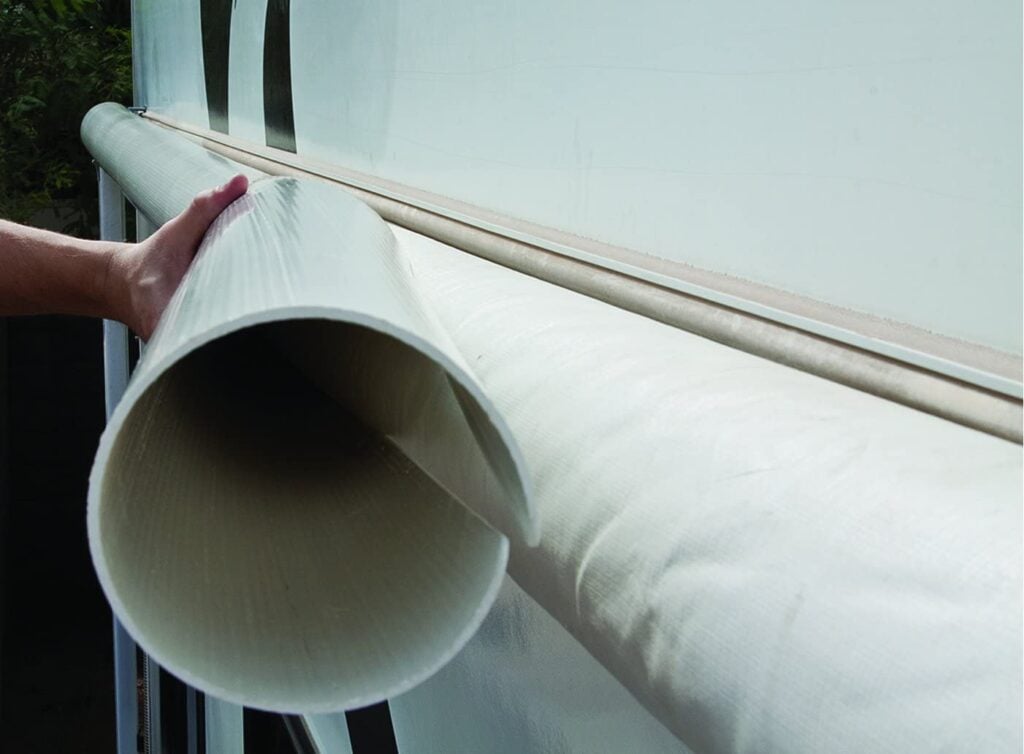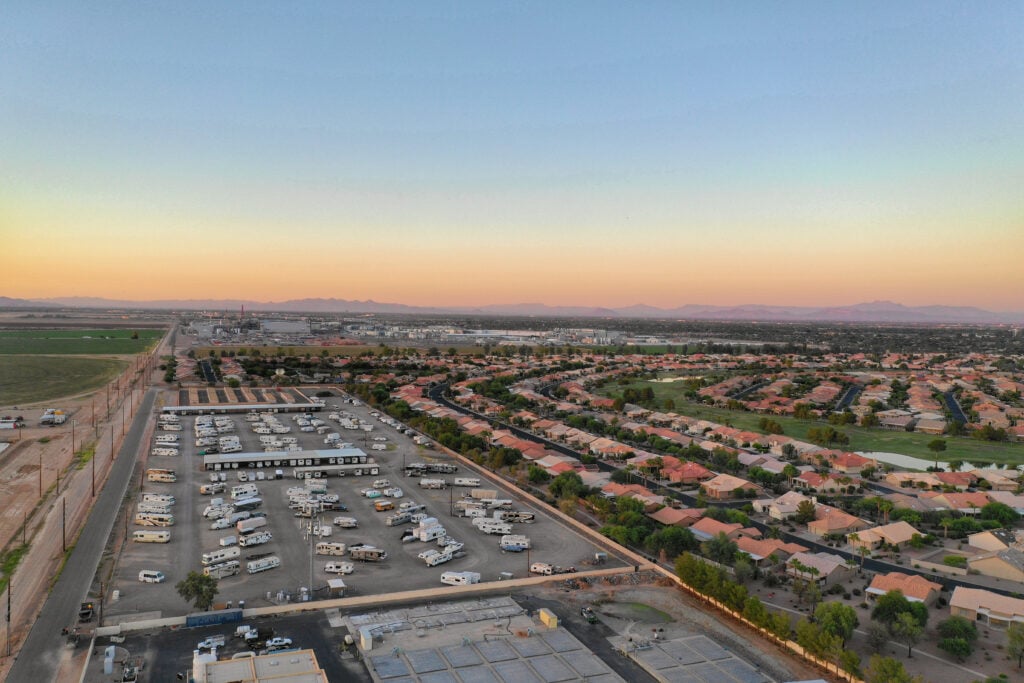
- Has your RV awning seen better days?
What’s the Best Way to Maintain RV Awnings?
One of the essential parts of the RV life experience is sitting out under your awning. This pull- or roll-out stretch of fabric extends out from your RV and protects you from the sun and rain. It helps you create an outdoor space where you can relax safe from the elements.
But protecting you from all that sun and rain is hard work for your awning. Unfortunately, even when rolled up, an awning is still exposed to heat, moisture, and UV rays. Furthermore, no amount of cleaning can protect your awning from the elements.
Thankfully, there’s a way to change that. An RV awning protector will keep your awning safe when stored away. So what are these devices, and how do they work?

- RV awning protector by Awning Pro-Tech. Photo from Amazon.
What is an RV awning protector?
An RV awning protector at its most basic is a small cover that protects your awning from the elements when it is stored away. This way, it isn’t damaged or worn out in any way when not in use. RV awning protectors most commonly take the form of some kind of tube that slips over the rolled-up awning.
These protectors can be made from a variety of materials. The most common are plastic and aluminum, but other materials such as vinyl can also be used.
In addition to the long tube style protectors, there are other varieties, such as a piece of vinyl that rolls up with the awning.
RV awning protectors start around $100 and go up from there, depending on the size of your awning and the exact product. Various designs for DIY awning protectors can also be found if you’re on a budget. But, who actually needs an RV awning protector?
Who needs an RV awning protector?
If you have an awning, there’s a pretty good chance you’ll want a protector for it. In fact, a better question might be: who doesn’t need an RV awning protector? Although you can get by without one, there are very few downsides to having a protector on your awning.
Basically, anyone who stores their RV uncovered can greatly benefit from an awning protector.
With a protector, you’ll be able to not only protect your awning but increase its lifespan. Even though your awning is designed to withstand the elements, it will eventually become worn out and need replacement.
With an RV awning protector, you can help maximize the lifespan of your awning by minimizing its exposure to the elements.

Pros and cons of RV awning protectors
So, what are the pros and cons of RV awning protectors at a glance? Let’s take a look.
Pros
- A cover will protect your awning and extend its lifespan.
- They can save you money over time by helping you avoid (or seriously delay) needing to replace your awning.
- They are simple to DIY.
Cons
- The upfront costs are a bit pricey. If you purchase a cover, expect to spend over $100.
- Using a protector can add to your list of to-dos. The protector has to be put on and taken off your rig in order to protect the awning.
- You will have to manually install your RV awning protector. This could be an issue if you don’t have a ladder or have reduced mobility.
One of the few downsides of getting a protector for your awning is the upfront cost. However, the cost of replacing an RV awning is much higher and can cost $1000s! So, purchasing a protector can save you money in the long run.
As for added time, a protector is going to be the most valuable while your RV is in storage. So you’re only putting the protector on once a season.
Overall, the downsides of getting a protector are very minor. Meanwhile, the benefits of having one are very notable.
What RV awning protector should you buy?
There are plenty of options for RV awning protectors on the market. Before you buy, however, you’ll need to measure your awning. Specifically, you’ll need to know the length of your awning so that you can be sure your cover will fit.
Once you have your measurement, you’re ready to buy. One of the most popular options is the kit from Awning Pro-Tech. This protector is made of UV-resistant polymer and comes in 4’ long sections that you install on the awning.
This protector easily snaps onto the awning for simple installation. If you want to use this protector while you’re on the road, Awning Pro-Tech also provides transport clips to keep the RV awning protector in place during transport.
Another option is this protector from Fabricover. You can easily install this fabric-based cover over the awning and fix it in place with cinch straps. It has the advantage of being a bit cheaper than the Awning Pro-Tech cover. However, it also cannot be used while traveling, only when the RV is stationary.
DIY RV Awning Protector
If you want to save some money (or just prefer to do it yourself), you can find plenty of DIY RV awning protector designs online.
Aron Jemison makes use of corrugated drain pipe for the cover and costs less than $20.
Another example is from the Forest River forum. This forum user made a cover out of sections of roof gutter.
Due to the simple design of most RV awning protectors, they’re not too complex to make, and you can probably create a design of your own if you’re crafty.
Time to get protected!
An RV awning protector is an essential accessory for anyone with an awning on their RV. These devices can help protect your awning fabric and greatly extend its lifespan. They can even help you save money by helping you avoid a costly awning replacement!
Whether you buy or DIY, there are plenty of options out there for protectors. No matter who you are and what your RV is like, there’s sure to be an RV awning protector that fits your needs. So what are you waiting for? It’s time to get your awning protected!
RVers looking for valuable how-to information have learned to go to the experts. Forums such as iRV2.com and blog sites like RV LIFE, Do It Yourself RV, and Camper Report provide all the information you need to enjoy your RV. You’ll also find brand-specific information on additional forums like Air Forums, Forest River Forums, and Jayco Owners Forum.

I have had three RVS (TTs) now and the previous two ultimately had issues with the awning degrading. The third is too new to show any issues yet. However, the most notable degrading occurred at the point of mounting to the
RV body. I doubt if any of these tubes will reasonably cover the attachment point of the awning to the body of the RV. This is where the real issue is.
I have the exact same issue. It is expensive replacing the awning when only a short section rots out. If you get a good solution I would love to know. I just replaced mine last weekend and would rather not have to do it again in a few years.
I recall seeing some sort of material to apply to the top part of an awning. This seems far simpler and probably cheaper than manual covers.
Anybody know about this option?
My Winnebago awning rolls into a metal (aluminum) tube against the coach. Problem solved. Buy a good RV and you won’t have to worry!